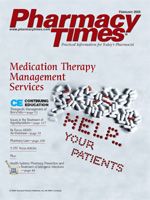Publication
Article
Pharmacy Times
Sports Injuries Are on the Rise
Many Americans finally are getting the message: routine exercise promotes health. Up to 36% of the population engages in routine exercise. From 1987 to 2001, health club membership increased by 135% for 35-to 54-year-olds and by 266% for those >55 years.1 Not surprisingly, sports injuries also have increased. Improper training, inappropriate footwear, disregard for safety equipment or protective gear, and rapid growth during puberty contribute to injuries. Ten percent of the annual 35 million to 40 million emergency room (ER) visits are sports-related, and injuries not requiring ER treatment may be 5 times as numerous.1 Table 1 lists the top 10 sports associated with injuries requiring medical intervention. More leisurely activities, such as golf or walking, however, are not risk-free. In 1999, for example, hospital ERs treated 131,975 golf-related injuries.2
Injury Categories
Sports injuries usually are caused by either traumatic (or acute) injury or muscle/joint overuse. Categories of injuries include the following:
- Lacerations (torn, ragged, mangled wounds) Almost 95% of all sports injuries and 60% of those occurring in children fall into these categories.3-5
Overuse or chronic injuries are more common than traumatic injuries. They happen over time. Repetitive training?such as running, overhand throwing, or serving a tennis ball?can cause overuse injuries. Overuse injuries also may result from repeating an intense workout too soon, regardless of fitness level. Exercise depletes muscle glycogen, which requires >48 hours to replace.4 Three types of overuse injuries are likely:
- Bursitis (inflammation of any shoulder, elbow, or knee bursa) Continuing to exercise when sustained pain occurs aggravates overuse injuries.
Although fractures seem common, they account for <5% of all sports injuries and <15% in children.3
Treatment
Pharmacists will find sports-medicine principles adaptable to all musculoskeletal injuries. Sports injuries need immediate attention. Minor pain, swelling, and discoloration associated with contusions are best treated as soon as they occur with Rest, Ice, Compression, and Elevation (R.I.C.E.; Table 2). R.I.C.E. also is first-line treatment for strains and ankle, knee, or wrist sprains.
Patients often misinterpret directions to apply ice to injuries and inadvertently damage their skin. Pharmacists should counsel patients as follows:
- After 24 hours, alternate ice and heat (whatever improves the condition; do not apply uncomfortable or burning heat) for 20 minutes every 3 to 4 hours7
An OTC analgesic of the patient's choice can relieve pain and inflammation. Inflammation is necessary to promote healing, so halting the inflammatory phase can theoretically delay musculoskeletal healing.8 It is prudent to recommend only short-term use of nonsteroidal anti-inflammatory drugs.6
Abrasions and Lacerations
Historically, clinicians cleansed abrasions with soap and water or a mild antiseptic wash (eg, hydrogen peroxide), then applied antibiotic ointment and a dry dressing. These measures are no longer advised. Wound scrubbing can increase damage and exacerbate the inflammatory response. Additionally, topical antimicrobials can be detrimental to fibroblasts needed for wound healing.9,10 Flushing, using bulb syringes or similar devices containing a nontoxic surfactant (eg, 0.9% sodium chloride solution), and applying a hydrocolloid dressing or a semiocclusive hydrogel dressing, covered with gauze, is better.9 The oxygen permeability of moist dressings promotes cell migration, wicks excess exudate, and occludes bacteria and other contaminants, allowing healing from the bottom and edges.9,10 All lacerations, including clean cuts, should be considered contaminated, and they should be thoroughly cleaned with antibacterial agents. Skin tape may be sufficient for superficial lacerations, but?depending on location, bleeding, and damage severity? lacerations into the dermal layer may need sutures. Wounds generally should be sutured within 8 hours of injury. Cosmetic concerns generally prompt meticulous care of facial lacerations.
Red Means Stop!
Serious bleeding, bruising, or pain is nature's way of saying that "the game is over,"even though many sports enthusiasts self-treat or downplay injuries. Patients should be referred to a physician or an ER for more serious conditions, or if pain or swelling persists or fails to improve. Torn ligaments or muscles may require surgical repair. Peri-or intra-articular corticosteroid injections can relieve pain and reduce swelling when used with analgesics and rest. They can delay healing and increase tendon rupture risk, however. Repeated injections can soften cartilage, so only occasional injections are recommended. Physicians also may recommend orthotics to protect or realign feet. Activity avoidance is a must while healing progresses. Die-hard athletes or patients concerned about maintaining fitness should be advised to take up an alternative sport. For each week of rest, they should count on 2 weeks of exercise to reach preinjury fitness levels. Return to full athletic activity should be gradual and pampered. Finally, as the virtues of exercise are extolled for the elderly, problems of misdiagnosis are possible. Joint pain may be caused by a repetitive sports injury or by the progression of arthritis. All patients should be counseled to discuss sports participation and exercise programs with their providers.
Dr. Zanni is a health systems consultant based in Alexandria, Va. Ms. Wick is a Senior Clinical Research Pharmacist, National Cancer Institute, National Institutes of Health. The views expressed are those of the authors and not those of any government agency.
For a list of references, send a stamped, self-addressed envelope to: References Department, Attn. A. Stahl, Pharmacy Times, 241 Forsgate Drive, Jamesburg, NJ 08831; or send an e-mail request to: astahl@mwc.com.







